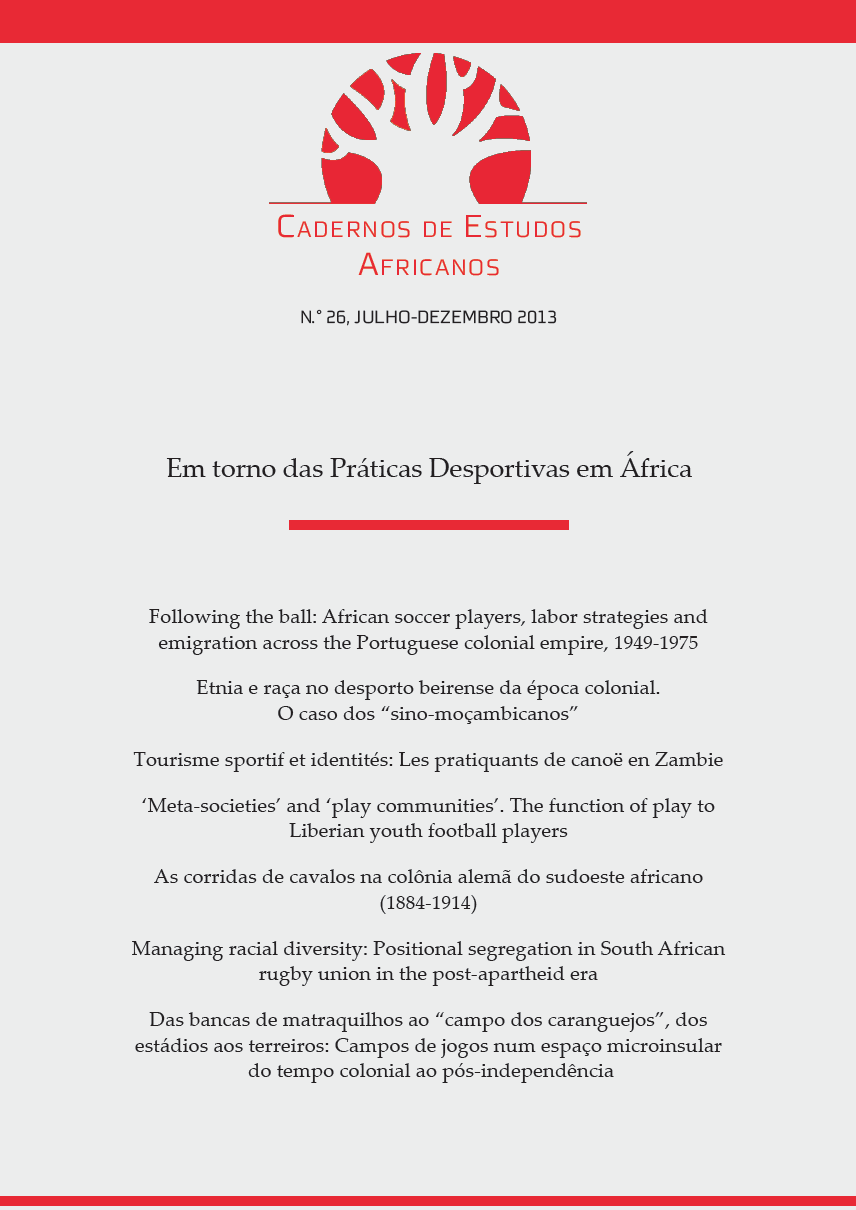‘Meta-societies’ and ‘play communities’. The function of play to Liberian youth football players
DOI:
https://doi.org/10.4000/cea.1135Keywords:
youth, community, football, play, culture, statusAbstract
This inquiry considers three distinct areas, firstly the Liberian definition of ‘youth’ and their post-conflict identity, secondly the tradition of community and the post conflict living arrangements, and thirdly the theme of this investigation, the use and participation of football and play amongst the ‘youth’ male population; its structure, rules, function, role, frequency, meaning and relationship to the wider society and status.References
Argenti, N. (2007). The intestines of the State: Youth, violence, and belated histories in the Cameroon grassfields. Chicago & London: The University of Chicago Press.
Caillois, R. (1961). Man, play and games. Urbana & Chicago: University of Illinois Press.
Cote, J. E. (2000). Arrested adulthood: The changing nature of maturity and identity. New York & London: New York University Press.
O’Brien, D. C. (1996). A lost generation? Youth identity and State decay in West Africa. In Werbner, R., & Ranger, T. (Eds.), Postcolonial identities in Africa (pp. 55-74). London & New Jersey: Zed Books.
Dalton, G. (1965). History, politics, and economic development in Liberia. The Journal of Economic History, 25 (4), 569-591.
European Youth Forum. (n.d). Report on youth NGOs: Reaching out to more young people and in particular, disadvantaged young people. In http://www.youthknot.net/uploads/documents/reaching-youth.pdf (accessed May 15, 2012).
Henricks, T. S. (2006). Erving Goffman on play as encounter. In Henricks, T. S., Play reconsidered: Sociological perspectives on human expression (pp. 146-180). Urbana: University of Illinois Press.
Huizinga, J. (1950). Homo ludens. A study of the play-element in culture. Boston: The Beacon Press.
Moran, M. H. (2006). Liberia: The violence of democracy. Philadelphia: University of Pennsylvania Press.
Olofson, H. (1977). Playing a kingdom: A Hausa meta-society in the walled city of Zara, Nigeria. In Lancy, D. F., & Tindall, B. A. (Eds.), The anthropological study of play: Problems and prospects (pp. 167-175). West Point, N. Y.: Leisure Press.
USAID. (2009). Liberia youth fragility assessment. In http://pdf.usaid.gov/pdf_docs/PN ADQ258.pdf (accessed May 10, 2012).
Utas, M. (2005). Building a future? The reintegration and re-marginalisation of youth in Liberia. In Richards, P. (Ed.), No peace, no war: An anthropology of contemporary armed conflicts (pp. 137-154). Oxford & Athens: James Currey & Ohio University Press.
Vigh, H. (2006). Social death and violent life chances. In Christiansen, C., Utas, M., & Vigh, H. E. (Eds.), Navigating youth, generating adulthood: Social becoming in an African context (pp. 31-60). Uppsala: Nordiska Africainstitutet.
Downloads
Published
Issue
Section
License
Copyright (c) 2016 Cadernos de Estudos Africanos

This work is licensed under a Creative Commons Attribution-NonCommercial-ShareAlike 4.0 International License.
I authorize the publication of the submitted article/review of which I am the author.
I also declare that this article is original, that it has not been published in any other way, and that I exclusively assign the publication rights to the journal Cadernos de Estudos Africanos. Reproduction of the article, in whole or in part, in other publications or on other media is subject to the prior authorization of the publisher Centro de Estudos Internacionais do Iscte - Instituto Universitário de Lisboa.


